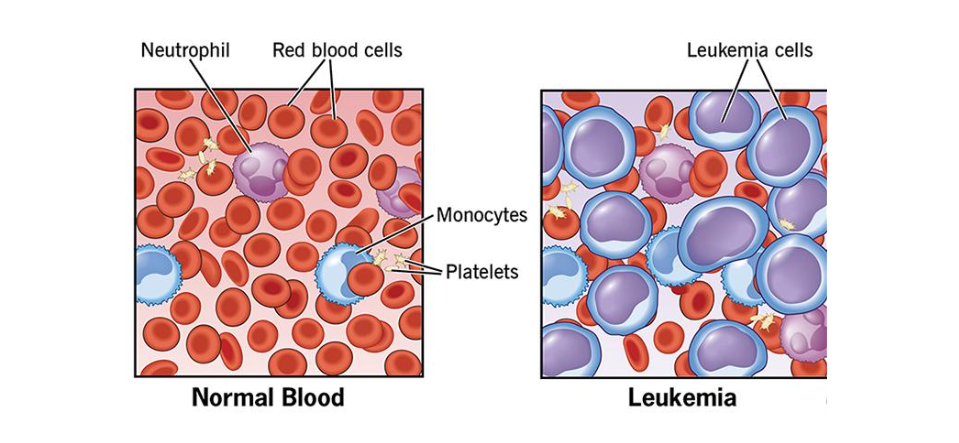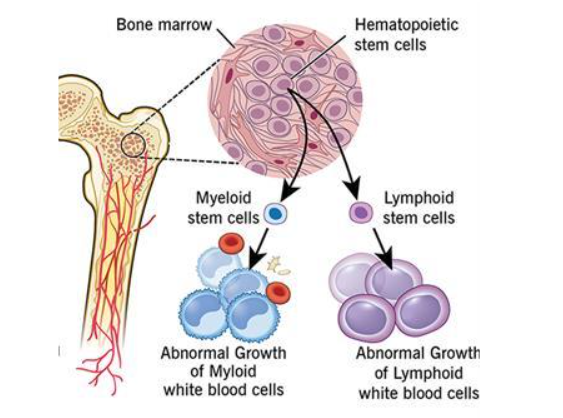August 23, 2022
Leukemia is a group of blood cancers that usually begin in the bone marrow and result in a high number of abnormal blood cells. These blood cells are not fully developed and are called Blast or Leukemia cells.
Symptoms may include bleeding and bruising, bone pain, fatigue, fever, and increased risk of infections.
These symptoms occur due to a lack of normal blood cells. Diagnosis is typically made by blood tests or Bone marrow biopsy. The exact cause of leukemia is unknown. A combination of genetic factors and environmental (non-inherited) factors is believed to play a role.
Risk factors include smoking, radiation, some chemicals (such as benzene), prior chemotherapy, and Down syndrome. People with a family history of leukemia are also at higher risk.
Leukemias and lymphomas both belong to a broader group of tumors that affect the blood, bone marrow, and lymphoid system.
There are four main types of leukemia.
- Acute Lymphoblastic leukemia (ALL)
- Acute myeloid leukemia (AML)
- Chronic lymphocytic leukemia (CLL).
- Chronic myeloid leukemia (CML)-as well as a number of less common types.
Treatment may involve some combination of chemotherapy, radiation therapy, and bone marrow transplant.
The success of treatment depends on the type of leukemia and the age of the person.
- Outcomes have improved in the developed world. 5year survival rate is 57% in the United States. In children under 15, the five-year survival rate is greater than 60% or even 90%, depending on the type of leukemia. In children with acute leukemia who are cancer-free after five years, the cancer is unlikely to return.
- In 2015, leukemia was present in 2.3 million people worldwide. However, over 90% of all leukemias are diagnosed in adults, with CLL and AML being most common in adults. It occurs more commonly in the developed world.
A blood test showing an abnormal white cell count may suggest the diagnosis.
To confirm the diagnosis and identify the specific type of leukemia, a needle biopsy and aspiration of bone marrow from a pelvic bone will need to be done to test for leukemic cells, DNA markers, and chromosome changes in the bone marrow.
What is Leukemia?
Leukemia is a cancer of the blood and bone marrow. In simple terms, cancer is defined as the uncontrolled growth of abnormal cells. Cancer can develop anywhere in the body. In leukemia, this rapid, out-of-control growth of abnormal cells takes place in the bone marrow of bones. These abnormal cells then spill into the bloodstream. Unlike other cancers, leukemia generally doesn’t form into a mass (tumor) that can be seen in imaging tests, such as X-rays.
What is bone marrow?
Bone marrow is the soft, spongy tissue in the center cavity of all bones. It is a limited space where all the different types of blood cells are made and where nutrients and other resources are supplied to help these cells grow. More specifically, the different types of blood cells produced in the bone marrow include:
- Red blood cells. These cells carry oxygen and other materials to all tissues and organs in the body.
- White blood cells. These cells fight infection.
- Platelets. Platelets help the blood clot.
Hundreds of billions of new blood cells are produced in the bone marrow each day, providing your body with a constant supply of fresh, healthy cells.
- What causes leukemia?
Leukemia starts when the DNA of a single cell in the bone marrow changes (mutates) and can’t develop and function normally. (DNA is the “instruction code” for the cell’s growth and function. Segments of DNA make up genes, which are arranged on larger structures called chromosomes. All cells that arise from that initial mutated cell also have the mutated DNA.
What causes the damage to the DNA in the first place is still not known in all cases.
As stem cells in bone marrow begin to divide and multiply, they develop into all the needed types of blood cells. In patients with leukemia, cell growth goes “haywire,” and there is a rapid growth of abnormal white blood cells.
So inside the bone marrow, blood cells begin to multiply and divide into red blood cells, white blood cells, and platelets. However, if you have leukemia, one of these blood cell types begins to rapidly multiply, in an out-of-control manner. These abnormal cells – called leukemia cells begin to take over the space inside the bone marrow. They crowd out the other normal cell types that are trying to develop.
- Acute leukemia. The leukemia cells are rapidly dividing and the disease progresses quickly. Acute leukemia is the most common pediatric cancer.
- Chronic leukemia. Often, these leukemia cells have features of both immature and mature cells. The disease typically worsens slowly as compared to acute leukemia. If you have chronic leukemia, you may not have noticeable symptoms for years. Chronic leukemia is more commonly seen in adults as compared to children.
By cell type:
- Myelogenous or myeloid leukemia means leukemia has developed from the myeloid cell line.
- Lymphocytic leukemia means leukemia has developed from the lymphoid cell line. There are four major types of leukemia:
Acute myeloid leukemia(AML): This is the most common type of acute leukemia. It is more common in older adults (those over 65 years of age) and in men compared with women.
Acute lymphocytic leukemia (ALL): This is the most common type of leukemia in children, teens, and young adults(up to 39 years of age).
Chronic myelogenous leukemia (CML): This leukemia is more common in older adults (most common in those over 65 years of age) and in men. It rarely occurs in children.
Chronic lymphocytic leukemia(CLL): This is the most common chronic leukemia in adults.
In addition to these four main types of leukemia, there also are various subtypes of leukemia.
Blood cell examination. Blood samples may be taken and checked for the type and shape of blood cells and examined. Other tests may help identify chromosomal abnormalities and other markers on the cells that help identify the type of leukemia.
Bone marrow aspiration and biopsy: If your white blood cell count is abnormal, the doctor will get a sample of cells from your bone marrow. A bone marrow biopsy helps determine the percentage of abnormal cells in the bone marrow, which confirms the diagnosis of leukemia.



















